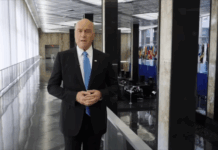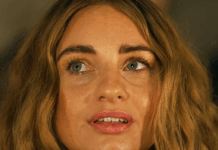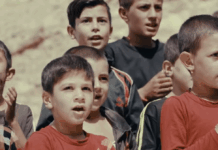By Steve Rees —
Contemplate the unimaginable: You survive an abortion attempt and later in life intentionally meet two people who killed preborn babies in the wombs of their birth mothers.
Or consider you are an abortionist coming face to face with survivors – one of whom emerged alive from a lethal salt solution – and the other a twin whose sister was torn apart inside her mother’s uterus in procedures you once performed.
As an abortionist and survivor, what would you say to each other if given the opportunity?
For two ex-abortionists who are now pro-life and two faith-filled abortion survivors, the conversation touches on forgiveness, repentance, grace, regret, compassion, respect and healing.
Meeting face to face with a camera recording their conversation, abortion survivors Melissa Ohden and Claire Culwell ask questions of ex-abortionists Anthony Levatino and Kathi Aultman, who share their perspectives on killing 1,200 and 500 preborn babies, respectively, until each dramatically turned pro-life.
The doctors and survivors boldly and transparently divulge the pain they inflicted and realized, resulting in forgiveness and healing between them.
Produced by Lila Rose, founder and president of Live Action | Pro-Life Advocacy for Dignity and Human Rights, an eight-part video series titled Face to Face unites survivors, ex-abortionists, women who regret decisions to kill their preborn babies, and former abortion employees in truthful, first-hand, up-close conversations.
Surviving an abortion that ended the life of her twin, Culwell said she has always wondered what her sister experienced during a procedure that’s called dilation and evacuation (D&E).
Dr. Levatino, who performed abortions for five years from 1980-85, answered Culwell’s question by stating her twin felt “everything as far as being pulled apart.”
Initially performing first-trimester abortions, Aultman learned the technique that was used to kill Culwell’s twin. The ex-abortionist dismembered “good-sized babies” up to 24 weeks, driven by the “technical challenge.” “The bigger the better,” Aultman said.
“I was so focused on helping the woman that, even as I counted the body parts, I did not see them as human – as people. I never considered what the baby was feeling, and we now know that they feel pain. I can’t imagine the excruciating pain they suffered at my hands,” she added.
Later, Aultman apologized to the survivors, thanking them and God for forgiveness.
Initially focused on saline abortions, Levatino said the solutions he used burned the babies before their mothers delivered intact, dead bodies scarred by chemicals.
Surviving the saline solution intended to kill her, Ohden thinks her mother was 31-weeks pregnant, though medical records indicate she was 18- to 20-weeks pregnant; she believes they’re wrong.
“I soaked in that toxic salt solution my birth mother experienced over a five-day period and the belief was of course that it would successfully end my life,” said Ohden, who was 31 weeks old in her mother’s womb.
“The day that I now celebrate as my birthday is the day that I was accidentally born alive,” Ohden said.
Survivor Culwell said her mother – at 20 weeks into pregnancy – underwent a D&E abortion.
“She was home for about four weeks before going back to the doctor who said the abortion was successful on one baby but that I had survived the D&E. I was born a few weeks later – 10 weeks premature weighing three pounds – with a dislocated hip and clubbed feet,” Culwell said.
“It’s hard for me to hear that the humanity of my twin was not recognized as you pieced babies’ bodies back together,” she added.
The pain her mother felt is something Culwell has always wanted to ask an abortionist.
Serving at an abortion-survivors network, Ohden frequently hears from women who say their mothers didn’t receive an exam to accurately determine ages before the procedures.
Working in an office – not in a free-standing abortion clinic – Levatino said he performed free ultrasounds on every abortion patient.
“I hear now about medical or chemical abortion being done with internet websites, where contact with the patient is limited to either a video chat or text. This is dangerous,” Levatino said.
Ohden asked the doctors what they would have done if they had confirmed her mom was 31 weeks pregnant before the abortion.
“If she was 31-weeks pregnant we’d say, ‘Ma’am were going to see you for your prenatal care,’ and then we would talk to her in terms of ‘if you don’t wish to raise a child, we can help you with adoption,’” said Levatino, who performed first- and second-trimester abortions.
Dr. Aultman admitted it is difficult for her to be with abortion survivors because, as a perpetrator, her actions toward them were evil. As a doctor, Aultman thinks about the babies she aborted.
“I’m just thankful for your forgiveness, which you’ve both given me,” Aultman said. “I’m just thankful that God ran after me and grabbed me out of that situation. He allows me now to try and save babies instead of killing them,” she added.
Dr. Levatino thinks about the preborn babies he killed through abortion believing that, when it’s his time, he’ll be reunited with his five-year-old daughter, a brother, and the 1,200 people whose lives ended tragically at his hands.
“Thank you very much for being willing to admit what you’ve done and allow it to be used to expose the truth to protect women like our birth mothers. I know it can’t be easy,” Culwell told the doctors.
Women should know that abortion is predicated on a colossal lie, nor is it the answer, according to Aultman. “Women don’t need abortion to succeed, and it is not healthcare,” she said.
Though ex-abortionists, Aultman and Levatino are physicians by training – a point survivor Ohden emphasized. “I look at you Dr. Aultman and don’t think of you as a former abortionist; I think that’s Dr. Aultman,” she said.
Listen to more of the conversation here: Honest Conversation Between Abortion Survivors and Providers | Face to Face – YouTube



